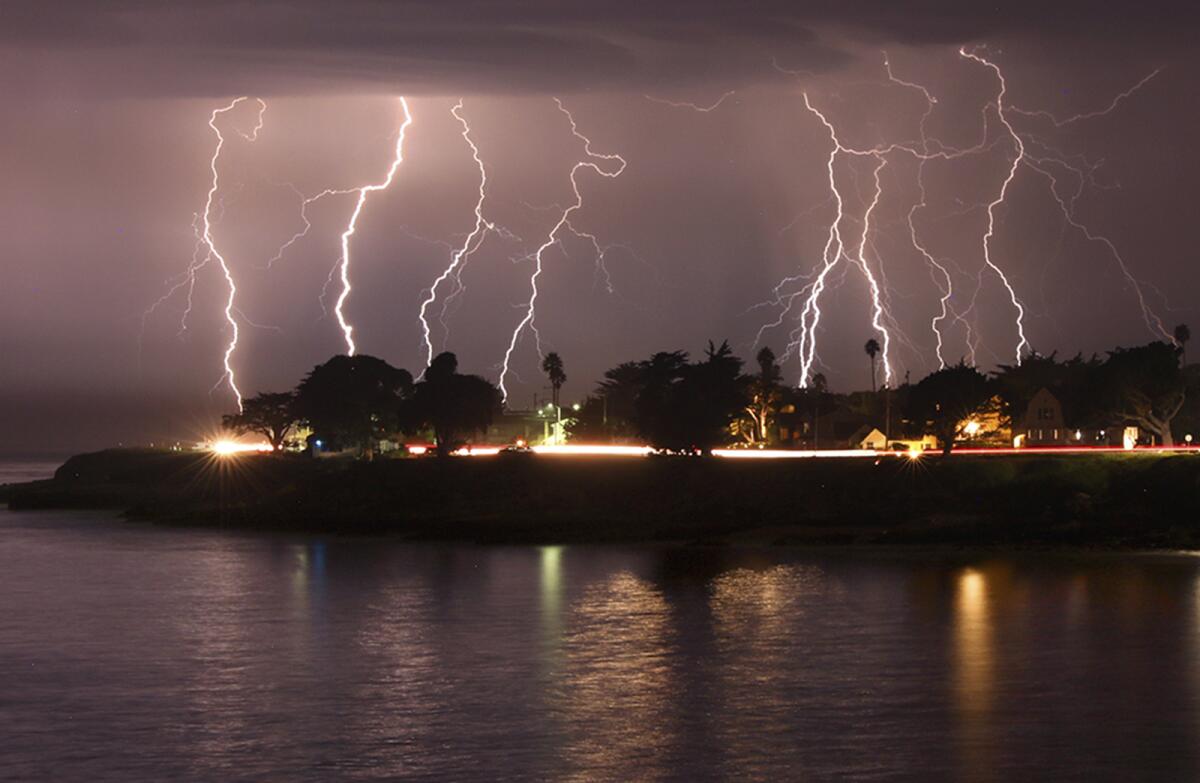‘Fires of hell’: How dry lightning has sparked some of California’s biggest infernos

- Share via
Federal officials described them as the “fires of hell,” a “holocaust” that blackened 775,000 acres of timber and chaparral and produced miles-high clouds resembling a nuclear bomb blast.
It was the Siege of ’87, when two weeks of dry lightning strikes in late August and early September sparked thousands of wildfires in Northern California and Oregon, drawing an army of 19,000 firefighters.
In 1999, hundreds of lightning-caused fires in the Big Sur region and the state’s north merged into two of the nation’s top blazes that year.
During a 33-hour period in June of 2008, more than 5,000 lightning strikes ignited some 1,000 fires across Northern California, the Sierra Nevada and the Central Coast.
This month’s explosion of lightning-sparked fires in the Bay Area will undoubtedly go down in the record books as the Siege of 2020. In the span of a week, some of them have merged together to form the second- and third- largest wildfires in modern state history.
But big fires ignited by storms that streak the skies with thousands of lightning bolts are nothing new.
Though California’s most destructive wildfires are often caused by people or equipment during high winds, many of the state’s largest recorded blazes have started with lightning strikes in the north or the Central Coast.

As of Saturday morning, the LNU Lightning Complex fire in the Napa-Sonoma County region had scorched more than 300,000 acres, making it the state’s second-largest after 2018’s human-caused Mendocino Complex fire.
At roughly 292,000 acres, the SCU Complex fire in the East Bay region is the third-largest.
The enormous volume of lightning strikes — some 12,000 — and the number of ignitions — 585 so far — makes it impossible for firefighting crews to contain many of the starts before they blend together, forming monsters that can burn for weeks or even months before dying out.
There is likely more to come, given the forecasts of thunderstorms, dry lightning and wind gusts for the Bay Area on Sunday and Monday.
Though the scale of the last week’s dry lightning strikes seems extraordinary, Cindy Palmer, a meteorologist in the Bay Area office of the National Weather Service, said it wasn’t that unusual.
“I think people have short memories,” she said.
Two colliding weather systems — tropical moisture from the south and a high-pressure ridge from the east — are producing thunderstorms that spit out lightning but little rain. Last weekend, Palmer said, lightning struck in one spot 10 miles from the nearest rainfall.
The moisture in the storm systems is in the higher atmosphere, and much of it evaporates before it reaches Earth’s surface.
“It’s not that these storms aren’t raining,” Palmer said. “It’s that they’re not producing enough rain to stop a fire from starting.”
That is especially true after an exceptionally dry winter in Northern California, and a heat wave that has parched wildland vegetation.
Lightning strikes are relatively rare in coastal Southern California. But they do occur in the mountains and deserts during the summer monsoon season.
A recent lightning strike sparked the Dome fire, which incinerated stands of Joshua trees in the Mojave National Preserve.
When Jon Keeley, a scientist with the U.S. Geological Survey, and research ecologist Alexandra Syphard analyzed California wildfire ignitions, they found that lightning was the cause of the majority of blazes in Northern California forests but accounted for less than a quarter of the starts in Southern California’s four national forests.
The Southland’s worst wildfires are driven by Santa Ana winds — and are almost always caused by people, downed power lines or equipment sparks.
More to Read
Sign up for Essential California
The most important California stories and recommendations in your inbox every morning.
You may occasionally receive promotional content from the Los Angeles Times.











